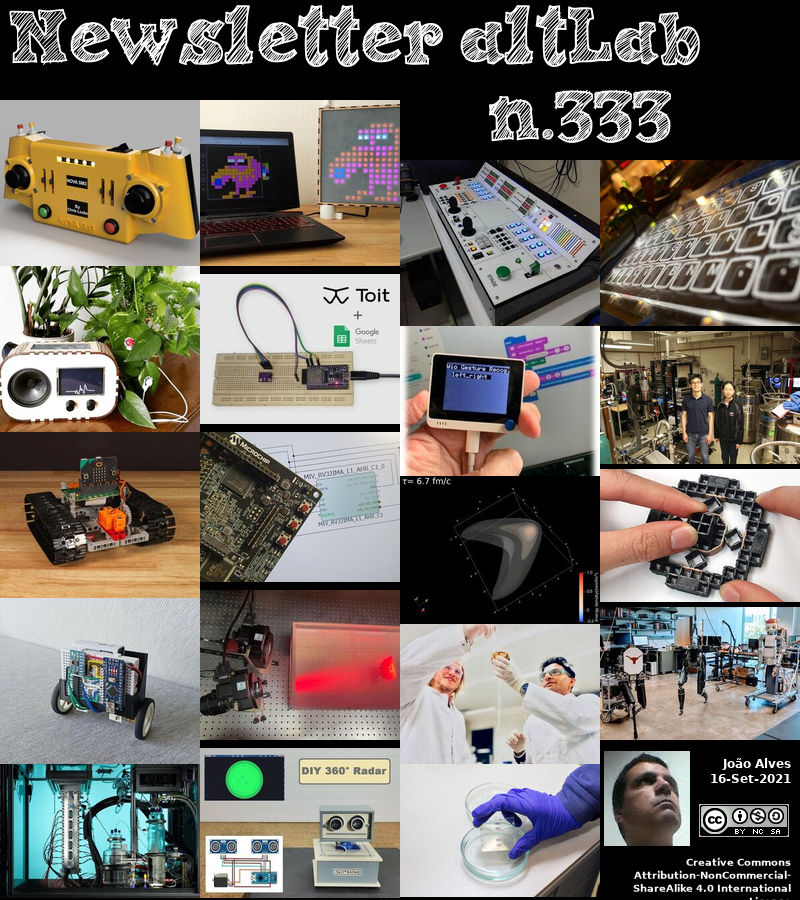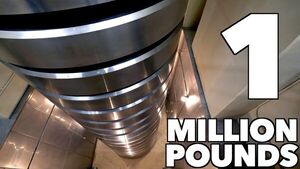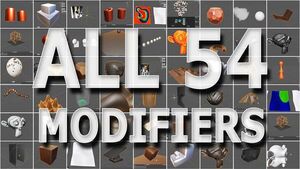2021-09-16 - Nº 333
Editorial
Esta é a Newsletter Nº 333 que se apresenta com o mesmo formato que as anteriores. Se gostar da Newsletter partilhe-a!
Todas as Newsletters encontram-se indexadas no link.
Esta Newsletter tem os seguintes tópicos:
Faz hoje anos que nascia, em 1804, o engenheiro civil, inventor e teórico norte-americano Squire Whipple. Ele forneceu as primeiras regras de base científica para a construção de pontes, foi considerado um dos melhores engenheiros do século XIX, e era conhecido como o "pai das pontes de ferro". Começou a sua carreira como construtor de pontes em 1840, desenhando e patenteando uma treliça de ponte de ferro. Durante os dez anos seguintes, construiu várias pontes no canal do Erie e nos caminhos-de-ferro de Nova Iorque e Erie. O seu desenho da ponte de chicote de treliça Whipple foi o modelo para centenas de pontes que atravessaram o Canal Erie no final do século XIX. Antes de desenvolver o seu desenho, Whipple trabalhou durante vários anos em levantamentos, estimativas e relatórios para a ampliação do Canal Erie, e em 1840 patenteou uma balança para pesagem de barcos do canal Erie. Mais tarde, construiu a primeira balança de pesagem construída no Canal Erie. A invenção da máquina a vapor exigiu pontes que pudessem suportar cargas vivas pesadas e isto motivou Squire a voltar a sua atenção para as pontes. Em 1853, completou uma ponte ferroviária de ferro de 146 pés de vão perto de West Troy (agora Watervliet), N.Y. O seu livro sobre o desenho de pontes utilizando métodos científicos (1847) foi o primeiro do seu género. As fórmulas e os seus métodos continuam a ser úteis.
Faz também hoje anos que nascia, em 1857, o engenheiro electrotécnico e inventor inglês Sydney Evershed. Ele co-fundou a firma de Evershed and Vignoles, Ltd., fabricantes de instrumentos eléctricos (reg. 5 Fev 1895). Em 1885, tornou-se gerente da pequena fábrica Goolden e Trotter, formada para fabricar o voltímetro Cardew. Adquiriu o negócio sucessor em 1895 com o seu assistente Ernest B. Vignoles. Os seus produtos tornaram-se internacionalmente conhecidos com a marca "Megger". Investigaram também os fenómenos magnéticos nos núcleos dos transformadores, ímanes permanentes, e a estrutura física dos não condutores. Ele concebeu um indicador de leme e importantes controlos de armas para a Marinha utilizados na I Guerra Mundial.
Faz igualmente hoje anos que nascia, em 1877, o inventor e fabricante americano Jacob Schick. Ele inventou a primeira máquina de barbear eléctrica a seco de sucesso. Começou no negócio das máquinas de barbear em 1925 para conceber e fabricar a sua invenção da revista "Repeating Razor". Em 1926, vendia clips de lâminas que podiam ser carregados numa máquina de barbear de segurança sem tocar na lâmina para evitar cortes durante o manuseamento. Enquanto este produto era bem sucedido, ele voltou a sua atenção para o desenvolvimento de uma lâmina de barbear seca. Em 1927, tinha concebido uma lâmina de barbear seca com uma cabeça de corte alternada, alimentada por um eixo de transmissão flexível para um motor externo. Embora tenha comercializado este modelo a partir de 1929, só em 1931 é que tinha melhorado a ideia como uma nova máquina de barbear eléctrica com uma só mão com motor autónomo que as vendas descolaram.
Por fim, faz hoje anos que nascia, em 1919, o inventor norte-americano Marvin Middlemark. Ele criou a antena de televisão "orelhas de coelho" entre as suas muitas patentes (1956-68) para electrónica de consumo (e ideias menores como um descascador de batatas movido a água), tornou-se um milionário que se fez sozinho.
Hoje é o dia internacional da protecção da camada de Ozono. Em 1987, nesta mesma data foi assinado, em Montreal no Canada, o protocolo que viria a estabelecer um conjunto de normas para proteger a camada de ozono através da eliminação gradual da produção de numerosas substâncias responsáveis pelo empobrecimento da mesma. Os compostos mais famosos são os CFCs - clorofluorcarbonetos - são compostos que possuem os átomos de cloro e flúor ligados a cadeias carbónicas, em geral, pequenas, como ao metano e ao etano. Portanto, eles fazem parte do grupo funcional dos haletos orgânicos. Até aos anos 70, estes gases eram amplamente utilizados como propulsores em aerossóis de perfume e insecticidas, como refrigerantes em frigoríficos e aparelhos de ar condicionado, e como gases de sopro para a produção de polímeros sob a forma de espumas. A sua utilização tornou-se generalizada devido às vantagens que estes compostos tinham, tais como serem inodoros, não tóxicos, e não inflamáveis. Contudo, quando um produto pulverizador que os continha era utilizado ou quando havia uma fuga no equipamento que os continha, os CFC eram libertados na atmosfera e descobriu-se que eram a causa do buraco na camada de ozono.
Começou por criar uma calculadora inovadora em 1972, foi responsável pela criação de computadores de baixo custo para utilização em casa ligados à televisão. Foi um percursor dos computadores pessoais como os conhecemos hoje. Na década de 80 criou o ZX80, o ZX81 e o mais famoso ZX Spectrum que permitiram a milhares de pessoas darem os primeiros passos na programação e servirem de inspiração a muitas gerações. Sir Clive Sinclair faleceu hoje aos 81 anos na sua casa em Londres.
Nesta semana que passou quatro norte-americanos descolaram do Centro Espacial Kennedy, na Florida a bordo de da cápsula Dragon da SpaceX, para uma viagem espacial de três dias. A grande novidade é que nenhum deles é um astronauta. Lançada acoplada ao foguetão Falcon 9, esta missão teve o nome de baptismo "Inspiration4" é considerada a primeira missão espacial totalmente civil e é também considerada o primeiro passo para uma abertura do espaço à sociedade civil. A bordo seguem o milionário Jared Isaacman, acompanhado por Hayley Arceneaux, Sian Proctor e Chris Sembroski. Todos eles foram treinados durante cerca de seis meses na base da SpaceX.
Na Newsletter desta semana apresentamos diversas noticias, artigos científicos, projetos de maker assim como alguns videos interessantes.
 João Alves ([email protected])
João Alves ([email protected])
O conteúdo da Newsletter encontra-se sob a licença  Creative Commons Attribution-NonCommercial-ShareAlike 4.0 International License.
Creative Commons Attribution-NonCommercial-ShareAlike 4.0 International License.
Novidades da Semana

SpaceX launches four civilians into orbit on historic Inspiration4 flight
"SpaceX made history tonight as it launched a crew of private citizens on a jaunt around Earth. For an added bonus, the rocket landed on its drone ship, marking the company's 92nd booster recovery. The mission, called Inspiration4, blasted off from Pad 39A at NASA's Kennedy Space Center here in Florida at 8:02 p.m. EDT (0002 GMT) — the start of a planned five-hour window. A four-person crew was strapped inside a Crew Dragon spacecraft which sat perched atop a slightly sooty 229-feet-tall (70 meters) Falcon 9 rocket. "Few have come before, and many are about to follow," Inspiration4 Cmdr. Jared Issacman said from inside the Crew Dragon spacecraft, referring to civilians in space." [...]
Outras Notícias

NASA Confirms Thousands of Massive, Ancient Volcanic Eruptions on Mars
"Some volcanoes can produce eruptions so powerful they release oceans of dust and toxic gases into the air, blocking out sunlight and changing a planet’s climate for decades. By studying the topography and mineral composition of a portion of the Arabia Terra region in northern Mars, scientists recently found evidence for thousands of such eruptions, or “super eruptions,” which are the most violent volcanic explosions known. Spewing water vapor, carbon dioxide, and sulfur dioxide into the air, these explosions tore through the Martian surface over a 500-million-year period about 4 billion years ago. Scientists reported this estimate in a paper published in the journal Geophysical Research Letters in July 2021. “Each one of these eruptions would have had a significant climate impact — maybe the released gas made the atmosphere thicker or blocked the Sun and made the atmosphere colder,” said Patrick Whelley, a geologist at NASA’s Goddard Space Flight Center in Greenbelt, Maryland, who led the Arabia Terra analysis. “Modelers of the Martian climate will have some work to do to try to understand the impact of the volcanoes.” After blasting the equivalent of 400 million Olympic-size swimming pools of molten rock and gas through the surface and spreading a thick blanket of ash up to thousands of miles from the eruption site, a volcano of this magnitude collapses into a giant hole called a “caldera.” Calderas, which also exist on Earth, can be dozens of miles wide." [...]

NASA’s Perseverance Rover Collects Puzzle Pieces of Mars’ History
"NASA’s Perseverance Mars rover successfully collected its first pair of rock samples, and scientists already are gaining new insights into the region. After collecting its first sample, named “Montdenier,” Sept. 6, the team collected a second, “Montagnac,” from the same rock Sept. 8. Analysis of the rocks from which the Montdenier and Montagnac samples were taken and from the rover’s previous sampling attempt may help the science team piece together the timeline of the area’s past, which was marked by volcanic activity and periods of persistent water. “It looks like our first rocks reveal a potentially habitable sustained environment,” said Ken Farley of Caltech, project scientist for the mission, which is led by NASA’s Jet Propulsion Laboratory (JPL) in Southern California. “It’s a big deal that the water was there a long time.” The rock that provided the mission’s first core samples is basaltic in composition and may be the product of lava flows. The presence of crystalline minerals in volcanic rocks is especially helpful in radiometric dating." [...]

Toshiba’s Polymer Film-Based Perovskite Large-Area Photovoltaic Module Reaches Record Power Conversion Efficiency of 15.1%
"Toshiba Corporation (TOKYO: 6502), the world-leader in development of perovskite photovoltaic modules for next-generation solar power generation, has developed a new coating method for the perovskite layer that boosts power conversion efficiency (PCE) to 15.1% for Toshiba’s 703cm2 module*1, the highest for any large, polymer film-based perovskite photovoltaic module*2. The innovative coating method for perovskite layer also greatly reduces production time and costs, contributing to a lower cost for solar power generation. Success in achieving carbon neutrality will require much greater use of photovoltaic power generation, and a significant expansion in locations where photovoltaic modules can be installed. Today’s most widely used photovoltaic modules are made with crystalline silicon and are heavy, and this, plus their rigidity, limits where they can be installed. The polymer film-based perovskite photovoltaic module is an attractive next-generation alternative, as it is thin, light and flexible, and can be installed in locations where it is difficult to use silicon photovoltaic modules, such as low load-bearing roofs and office windows. Recent improvements in the PCE of perovskite photovoltaic modules has brought them to a level comparable to that of silicon photovoltaic modules." [...]

New Arm technologies to transform the software-defined future for the automotive industry
"Arm, in collaboration with leaders across the automotive supply chain, today announced it is delivering a new software architecture and reference implementation, Scalable Open Architecture for Embedded Edge (SOAFEE), and two new reference hardware platforms to accelerate the software-defined future of automotive. As vehicle architectures and capabilities evolve, automotive developers today are challenged by the increasing code complexity needed to deliver Advanced Driver Assistance Systems (ADAS), In-vehicle Infotainment systems (IVI), electrified powertrains, and autonomy. To meet these evolving consumer demands, computing must become more centralized, and software is increasingly critical to allowing this. The resulting changes to how software is being developed, deployed, and managed means that cloud-native development, best known for driving reductions in cost, time and complexity across the cloud infrastructure industry, is more applicable to automotive development than ever before. However, to address the software-defined needs of cars today quickly and seamlessly, it is imperative to deliver a standardized framework that enhances proven cloud-native technologies that work at scale with the real-time and safety features required in automotive applications. This same framework can also benefit other real-time and safety-critical use cases such as robotics and industrial automation." [...]

STMicroelectronics and Blues Wireless Cooperate to Accelerate Adoption of Cellular Technology in Embedded Applications
"STM32 MCU, Motion and Temperature Sensor, STSAFE-A Secure Element and other products contribute to unique, highly secure, power-efficient embeddable cellular device-to-cloud data pump STMicroelectronics, a global semiconductor leader serving customers across the spectrum of electronics applications, and Blues Wireless, a telecoms equipment supplier putting people and businesses in touch with their physical assets by unlocking the vast potential of cellular IoT, have disclosed the use of a quintet of ST products in Blues Wireless’ Notecard, a system-on-module (SOM) solution that accelerates development of cellular IoT solutions for connected assets at very low cost. The Blues Wireless Notecard builds on a high-performance, ultra-low-power STM32L4R5 microcontroller (MCU), an STSAFE-A Secure Element for state-of-the-art key management and device security, and an LIS2DTW12 for temperature sensing, motion, and power-optimized location awareness. Around the ST products, the Notecard wraps pre-paid embedded cellular data service, secure communications, and an innovative development model that dramatically reduces the time from concept-to-deployment for a broad range of cloud-connected IoT applications. “Businesses are on a mission to accelerate digital transformation of their processes and one huge area of investment is connecting distributed physical assets. The Notecard from Blues Wireless is designed with the developers of these solutions in mind,” said Mobeen Khan, Chief Operating Officer at Blues Wireless. “Building with ST’s breadth of products, we have been able to develop this ultimate accelerator for IoT solutions which reduces the complexity and cost of IoT solutions by 10X.” “Up to now, the adoption of cellular connectivity for IoT devices has had two significant roadblocks." [...]

Low Power Asset Tag from onsemi Brings Unmatched Five-Year Battery Life to Industrial Asset Management
"onsemi, a leader in intelligent power and sensing technologies, unveiled a new system solution that overcomes the main challenges associated with developing asset tracking tags. Battery life has been a major obstacle to asset tag adoption, particularly within industrial sectors where reducing maintenance efforts and associated costs are a primary concern. The RSL10 Asset Tag offers an unprecedented, industry-leading battery life of up to five years. Until now, the accepted battery life for asset tracking tags or beacons has been just a year or even months. This game-changing battery life is made possible by the low power consumption of the RSL10 Bluetooth® 5 radio SoC and enhancements at the firmware level. Alongside the RSL10, the platform features a 3-axis accelerometer and environmental sensors (motion, pressure and temperature) to provide valuable data and insights into an asset’s environment, condition and orientation." [...]

Tokuyama and Panasonic Start the Demonstration of Pure Hydrogen Fuel Cell Generators That Use By-product Hydrogen
"Tokuyama Corporation and Panasonic Corporation today announced that they have started demonstration work on pure hydrogen fuel cell generators that use by-product hydrogen generated in Tokuyama's Tokuyama Factory in Shunan City, Yamaguchi Prefecture. The demonstration period is scheduled to end in March 2023. By-product hydrogen is derived from the manufacturing process of caustic soda. With the acceleration of worldwide efforts to achieve the decarbonization of society, interest in hydrogen as a next-generation source of energy has been growing. The effective utilization of by-product hydrogen is of great importance from the perspectives of not only global warming prevention and energy security, but also the chemical industry's contribution to society through the effective use of secondary products. For this demonstration, equipment was installed in the Tokuyama Factory." [...]

Renesas and OmniVision Deliver Integrated Reference Design For Automotive Camera Systems
"Renesas Electronics Corporation (TSE:6723), a premier supplier of advanced semiconductor solutions, and OmniVision Technologies, Inc., a leading developer of advanced digital imaging solutions, today introduced an integrated reference design for a High Definition automotive camera system. The new design features Renesas’ recently introduced Automotive HD Link (AHL) technology that transmits high-definition video over low-cost cables and connectors. The AHL components in the design pair with OmniVision's OX01F10 1.3MP SoC, which provides the industry's best imaging performance across a wide range of challenging lighting conditions, along with the most compact form factor and lowest power consumption. HD video is increasingly important in car safety systems for object recognition functionality. The new RAA279971 AHL encoder and RAA279972 decoder use a modulated analog signal to transmit the video, enabling transmission rates 10 times less than required to transmit HD signals digitally. The lower transmission rate means that unshielded twisted pair (UTP) cables and standard low-cost connectors can be used, as can existing traditional analog video cables and connectors." [...]

Toshiba Releases New M4G Group of Arm® Cortex®-M4 Microcontrollers for High-speed Data Processing in the TXZ+TM Family Advanced Class
"Toshiba Electronic Devices & Storage Corporation ("Toshiba") has started the mass production of 20 new devices in the M4G group for high-speed data processing as new products of the TXZ+TM family advanced class manufactured in a 40nm process. These products use Arm Cortex-M4 core with FPU, running up to 200MHz, integrating a maximum of 2MB code flash and 32KB data flash memory with 100K write cycle endurance, and features various interfacing and communication options. As a result, M4G group devices are ideally suited for office equipment, building and factory automation applications. Microcontrollers in the M4G group have enhanced communication functions integrated as a serial memory interface that also supports Quad/Octal SPI, audio interface (I2S), external bus interface in addition to UART, FUART, TSPI and I2C. In addition, the devices have an in-built 3-unit DMAC and a bus matrix structure, which greatly improves communication throughput compared to Toshiba's conventional product. These devices support a variety of sensing use cases with a high-speed, high-precision 12-bit analog/digital converter that allows individual sample hold times to be set for each AD input channel with up to 24 channels." [...]
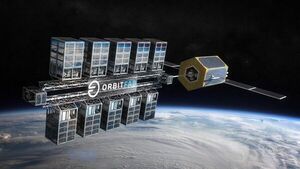
Refueling Satellites in Space
"Lockheed Martin is adding another tool to its innovative workbox of pioneering on-orbit satellite servicing capabilities with an investment in Orbit Fab’s Gas Stations in Space™ refueling technology. Orbit Fab, a San Francisco-based space-industry startup, has developed end-to-end refueling service using its Rapidly Attachable Fluid Transfer Interface (RAFTI). RAFTI, Orbit Fab’s first product, is a fueling port to allow satellites to be refueled easily in orbit. It can also be used as a drop-in replacement for existing satellite fill-and-drain valves. Accessing fuel in-orbit will allow satellite operators to defer capital costs, increase asset utilization and lifetime, and create the opportunity for new, flexible business models. Lockheed Martin Ventures, along with other investors, provided investment dollars for Orbit Fab’s refueling technology." [...]

Open source SystemVerilog tools in ASIC design
"Open source hardware is undeniably undergoing a renaissance whose origin can be traced to the establishment of RISC-V Foundation (later redubbed RISC-V International). The open ISA and ecosystem, in which Antmicro participated since the beginning as a Founding member, has sparked many open source CPU implementations, new tooling, methodologies, and trends which allow for more collaborative and software driven design. Many of those broader open hardware activities have been finding a home in CHIPS Alliance, an open source organization we participate in as a Platinum member alongside Google, Intel, Western Digital, SiFive and others, whose goals explicitly encompass: - creating and maintaining open source ASIC and FPGA design tools (digital and analog) - open source core and uncore IP - interconnects, interoperability specs and more This is in perfect alignment with Antmicro’s mission—as we’ve been heavily involved with many of the projects inside of and related to CHIPS providing commercial support, engineering services, and assistance in practical adoption for enterprise deployments. As of this time, a range of everyday design, development, testing, and verification tasks are already possible using open source tools and components and are part of our and our customer’s everyday workflow. Other developments are within reach given a reasonable amount of development, which we can provide based on specific scenarios. Others still are much further away, but with dedicated efforts inside CHIPS in which we are involved together with partners like Google and Western Digital, there is a pathway towards a completely open hardware design and verification ecosystem." [...]
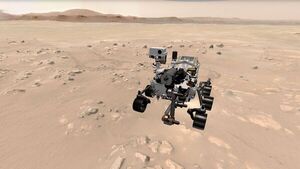
Take a 3D Spin on Mars and Track NASA’s Perseverance Rover
"Two interactive web experiences let you explore the Martian surface, as seen by cameras aboard the rover and orbiters flying overhead. It’s the next best thing to being on Mars: Two online interactive experiences let you check out Jezero Crater – the landing site and exploration locale for NASA’s Perseverance rover – without leaving our planet. One new experience, called “Explore with Perseverance,” allows you to follow along with the rover as though you were standing on the surface of Mars. Another interactive – “Where Is Perseverance?” – shows the current location of the rover and Ingenuity Mars Helicopter as they explore the Red Planet. It’s updated after every drive and flight and allows you to track the progress of Perseverance and Ingenuity, in their journeys on and above the Red Planet. Explore with Perseverance is made mostly with images taken by the rover from various vantage points, with additional images from the HiRISE (High Resolution Imaging Experiment) camera aboard NASA’s Mars Reconnaissance Orbiter overhead." [...]
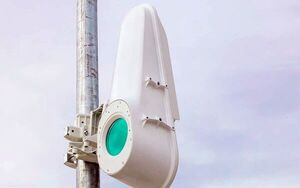
Beaming broadband across the Congo River
"Taara’s wireless optical communications links are now beaming light-speed connectivity from Brazzaville to Kinshasa across the Congo River What if we could bring fiber-like speeds to unconnected and underserved communities that, because of the geography or cost, fiber can’t reach? What if we could use what we learned beaming lasers between stratospheric balloons in the skies down here on earth? What if sacrificing a small amount of signal reliability actually led to millions more people around the world having access to faster, cheaper internet? These are just some of the questions the Project Taara team and I have been exploring as we work to plug connectivity gaps and expand global access to fast, affordable and abundant internet using wireless optical communication links. I’m delighted to share that working with Liquid Intelligent Technologies we recently helped bridge a particularly stubborn connectivity gap between Brazzaville in the Republic of the Congo and Kinshasa in the Democratic Republic of Congo. Separated by the Congo River, the world’s deepest and second fastest river, Brazzaville and Kinshasa are only 4.8 kilometers apart — yet connectivity is five times more expensive in Kinshasa because the fiber connection has to travel more than 400 kms to route around the river." [...]
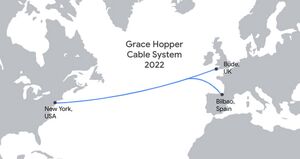
Our Grace Hopper subsea cable has landed in the UK
"Last year, we announced a new subsea cable — named Grace Hopper after the computer science pioneer — that will run between the United States, the United Kingdom and Spain. The cable will improve the resilience of the Google network that underpins our consumer and enterprise products. The 16-fibre pair Google-funded cable will connect New York (United States) to Bude (United Kingdom) and Bilbao (Spain). Today, the Grace Hopper cable has landed in Bude, Cornwall. Many people around the world use Google products every day to stay in touch with friends and family, travel from point A to point B, find new customers or export products to new markets. As our first Google-funded cable to the U.K., Grace Hopper is part of our ongoing investment in the country, supporting users who rely on our products and customers using our tools to grow their business." [...]

RISC-V Launches the Open Hardware Diversity Alliance
" RISC-V International, a global open hardware standards organization, today announced the launch of the Open Hardware Diversity Alliance. The global Alliance, created by CHIPS Alliance, OpenPOWER Foundation, RISC-V, and Western Digital, will develop and provide learning and networking programs, mentorship opportunities and inclusive environments across the expansive ecosystem of open hardware. The Alliance will be focused on supporting professional advancement and encouraging equal participation for women and underrepresented individuals in the open hardware community. “Communities benefit from a diverse set of ideas from the broad community. RISC-V is working to build, share, and support these inclusive opportunities by bringing new talent and ways of thinking to the open hardware community,” shared Kim McMahon, Director of Visibility and Community Engagement at RISC-V. “The Open Hardware Diversity Alliance will set the course for inclusivity in the open hardware community by building programs and diversity that inspires creativity and drives innovation.” The Alliance aims to fill the gaps and create opportunities to improve career development in open hardware design by providing underrepresented individuals with the necessary steps and fostering inclusive environments. By providing a supportive community, the program will help to drive professional growth, empower the development of technical careers, encourage the recognition of all ideas in technical innovations and support career growth." [...]

3 crew leave China’s space station for Earth after 90 days
" Three astronauts who lived for 90 days on China’s space station departed Thursday in preparation for returning to Earth. The national space agency said Nie Haisheng, Liu Boming and Tang Hongbo boarded the Shenzhou-12 spacecraft and undocked from the space station at 8:56 a.m. Thursday (0056 GMT). State broadcaster CCTV aired footage of the astronauts securing packages inside their spacecraft, which is due to parachute to a location in the Gobi Desert near the Jiuquan launch center on Friday. The astronauts have already set China’s record for the most time spent in space. After launching on June 17, mission commander Nie and astronauts Liu and Tang went on two spacewalks, deployed a 10-meter (33-foot) mechanical arm, and had a video call with Communist Party leader Xi Jinping. Before the undocking, the astronauts downloaded data from their experiments and ensured the station would continue operating without a crew, CCTV reported." [...]
Ciência e Tecnologia

Ethical Artificial Intelligence is Focus of New Robotics Program
"Ethics will be at the forefront of robotics education thanks to a new University of Texas at Austin program that will train tomorrow’s technologists to understand the positive — and potentially negative — implications of their creations. Today, much robotic technology is developed without considering its potentially harmful effects on society, including how these technologies can infringe on privacy or further economic inequity. The new UT Austin program will fill an important educational gap by prioritizing these issues in its curriculum. “In the next 10 years, we are going to live more closely alongside robots, and we want to be sure that those robots are fair, inclusive and free from bias,” said Junfeng Jiao, associate professor in the School of Architecture and the program lead. “And because the robots we create are reflections of ourselves, it is imperative that technologists receive an excellent ethics education. We want our students to work directly with companies to create practices and technologies that are equitable and fair.” Called CREATE (Convergent, Responsible, and Ethical AI Training Experience for Roboticists), it will offer graduate coursework and professional development in responsible design and implementation." [...]
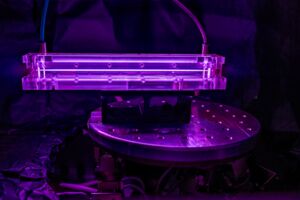
Unprecedented Plasma Lensing for High-Intensity Lasers
"High-power laser pulses focused to small spots to reach incredible intensities enable a variety of applications, ranging from scientific research to industry and medicine. At the Berkeley Lab Laser Accelerator (BELLA) Center, for instance, intensity is key to building particle accelerators thousands of times shorter than conventional ones that reach the same energy. However, laser-plasma accelerators (LPAs) require sustained intensity over many centimeters, not just a spot focus that rapidly expands because of diffraction. To achieve sustained intensity, the BELLA Center, at the Department of Energy’s Lawrence Berkeley National Laboratory (Berkeley Lab), uses thin hollow structures, or “capillaries,” containing a plasma to transport the pulses of light. BELLA Center scientists have been pushing toward longer and longer capillaries as they strive for higher beam energies with their LPAs. Their latest work shows, with higher precision than ever before, that these plasma waveguides are extremely stable and of reproducibly high quality, and that these characteristics can be maintained over distances as long as 40 centimeters." [...]

ITMO Researchers Create Nanoparticle Paste To Maximize Perovskite Solar Cell Efficiency
"An international team of researchers from ITMO’s School of Physics and Engineering and Tor Vergata University of Rome found a way to increase the efficiency of perovskite-based solar cells. The project was supported by a Russian Science Foundation grant and its results were described in a paper published in Nano Energy. The researchers developed a paste made from titanium dioxide and resonant silicon nanoparticles that serves as an additional layer in the process of producing solar cells. The Mie-resonant particles in the paste make it possible to control the amount of light absorbed and increase the generation of photocurrent, which allowed the researchers to bring the efficiency of solar cells up to 21%. Importantly, the experiments were conducted on halide (MAPbI3) perovskites, which are the most widespread and well-studied in the field of photovoltaics. Available materials Halide perovskites are some of the most promising materials in contemporary photovoltaics, however they have one significant drawback: their photoactive layer is only about 300-600 nanometers." [...]

Physicists engineer ferroelectricity in boron nitride
"New property in an ultrathin cousin of graphene could allow for much denser computer memory. Ultrathin materials made of a single layer of atoms have riveted scientists’ attention since the isolation of the first such material — graphene — about 17 years ago. Among other advances since then, researchers including those from a pioneering lab at MIT have found that stacking individual sheets of the 2D materials, and sometimes twisting them at a slight angle to each other, can give them new properties, from superconductivity to magnetism. Now MIT physicists from that lab and colleagues have done just that with boron nitride, known as “white graphene,” in part because it has an atomic structure similar to its famous cousin. The team has shown that when two single sheets of boron nitride are stacked parallel to each other, the material becomes ferroelectric, in which positive and negative charges in the material spontaneously head to different sides, or poles. Upon the application of an external electric field, those charges switch sides, reversing the polarization." [...]
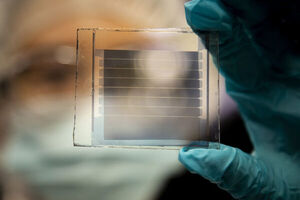
Solar cells with 30-year lifetimes for power-generating windows
"High-efficiency but fragile molecules for converting light to electricity thrive with a little protection. A new transparency-friendly solar cell design could marry high efficiencies with 30-year estimated lifetimes, research led by the University of Michigan has shown. It may pave the way for windows that also provide solar power. “Solar energy is about the cheapest form of energy that mankind has ever produced since the industrial revolution,” said Stephen Forrest, the Peter A. Franken Distinguished University Professor of Electrical Engineering, who led the research. “With these devices used on windows, your building becomes a power plant.” While silicon remains king for solar panel efficiency, it isn’t transparent. For window-friendly solar panels, researchers have been exploring organic—or carbon-based—materials." [...]
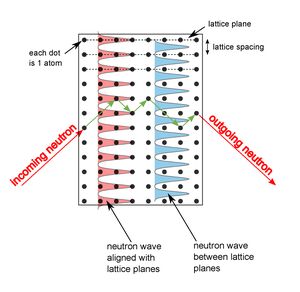
Groundbreaking Technique Yields Important New Details on Silicon, Subatomic Particles and Possible ‘Fifth Force’
"Using a groundbreaking new technique at the National Institute of Standards and Technology (NIST), an international collaboration led by NIST researchers has revealed previously unrecognized properties of technologically crucial silicon crystals and uncovered new information about an important subatomic particle and a long-theorized fifth force of nature. By aiming subatomic particles known as neutrons at silicon crystals and monitoring the outcome with exquisite sensitivity, the NIST scientists were able to obtain three extraordinary results: the first measurement of a key neutron property in 20 years using a unique method; the highest-precision measurements of the effects of heat-related vibrations in a silicon crystal; and limits on the strength of a possible “fifth force” beyond standard physics theories. The researchers report their findings in the journal Science. To obtain information about crystalline materials at the atomic scale, scientists typically aim a beam of particles (such as X-rays, electrons or neutrons) at the crystal and detect the beam’s angles, intensities and patterns as it passes through or ricochets off planes in the crystal’s lattice-like atomic geometry. That information is critically important for characterizing the electronic, mechanical and magnetic properties of microchip components and various novel nanomaterials for next-generation applications including quantum computing. A great deal is known already, but continued progress requires increasingly detailed knowledge." [...]

Vinny Fry: Wired for success
"MIT engineer oversees design and testing of key magnet components for the Institute's SPARC fusion project. Vinny Fry had only a rudimentary understanding of fusion energy, gleaned in part from “Iron Man” films, when he made the Google search that ultimately landed him a job as mechanical engineer at MIT’s Plasma Science and Fusion Center (PSFC). An undergraduate at Duke University, where he ran their 3D printing lab, Fry was interning at SpaceX but wanting a new challenge, one he felt would have a greater impact for the future of the planet. Working late one night, he typed into the search engine: 3D Printing Nuclear Fusion. Fry knew that fusion, which fuels the sun and other stars, is a potentially endless source of carbon-free energy on Earth. Researchers have spent decades exploring how to heat hydrogen fuel inside a doughnut-shaped “tokamak,” creating plasma that is hot and dense enough to produce fusion reactions." [...]
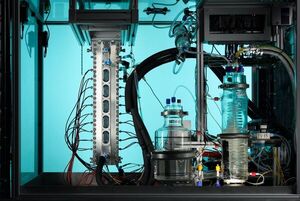
The electrolyzer enigma: how solving it could enable the energy transition
"TU/e is working with partners and companies on the production of electrolyzers that could enable large-scale use of green hydrogen. They have been around for a hundred years, but still, we barely understand electrolyzers. Significantly though, these devices can be used to produce green hydrogen, therefore playing an essential role in the energy transition. That’s more than enough reason to unravel the secrets of the electrolyzer and to engineer one that is efficient, affordable, and modular so that it can be used on a large-scale. TU/e is doing exactly this, within the so-called Dutch Electrolyzer consortium, together with partners and companies. In six questions we take you through the enigma of anodes, bubbles, and electrolytes." [...]
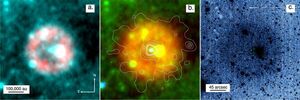
Astronomers solve 900-year-old cosmic mystery surrounding Chinese supernova of 1181AD
"A 900-year-old cosmic mystery surrounding the origins of a famous supernova first spotted over China in 1181AD has finally been solved, according to an international team of astronomers. New research published today (September 15, 2021) says that a faint, fast expanding cloud (or nebula), called Pa30, surrounding one of the hottest stars in the Milky Way, known as Parker’s Star, fits the profile, location and age of the historic supernova. There have only been five bright supernovae in the Milky Way in the last millennium (starting in 1006). Of these, the Chinese supernova, which is also known as the ‘Chinese Guest Star’ of 1181AD has remained a mystery. It was originally seen and documented by Chinese and Japanese astronomers in the 12th century who said it was as bright as the planet Saturn and remained visible for six months. They also recorded an approximate location in the sky of the sighting, but no confirmed remnant of the explosion has even been identified by modern astronomers." [...]

International team improves efficiency of liquid metal batteries
"Climate protection means increasingly turning to renewable energies. But in order to store the energy produced by solar, wind and other regenerative processes, sophisticated systems are required. Today’s storage options are still too expensive and hardly or even impossible to recycle. Scientists at HZDR’s Institute of Fluid Dynamics have been working on liquid metal batteries for several years and are now in the European vanguard. Together with the Massachusetts Institute of Technology (MIT), HZDR’s scientist Dr. Norbert Weber has managed to decisively optimize a novel lithium lead battery. As reported in the Journal of Energy Chemistry (DOI: 10.1016/j.jechem.2021.08.015), thanks to an improved electrolyte formulation, the team was able to increase the power efficiency to nearly 100 percent and the energy density by 45 percent at the same time." [...]

Have we detected dark energy? Cambridge scientists say it’s a possibility
"Dark energy, the mysterious force that causes the universe to accelerate, may have been responsible for unexpected results from the XENON1T experiment, deep below Italy’s Apennine Mountains. A new study, led by researchers at the University of Cambridge and reported in the journal Physical Review D, suggests that some unexplained results from the XENON1T experiment in Italy may have been caused by dark energy, and not the dark matter the experiment was designed to detect. They constructed a physical model to help explain the results, which may have originated from dark energy particles produced in a region of the Sun with strong magnetic fields, although future experiments will be required to confirm this explanation. The researchers say their study could be an important step toward the direct detection of dark energy. Everything our eyes can see in the skies and in our everyday world – from tiny moons to massive galaxies, from ants to blue whales – makes up less than five percent of the universe. The rest is dark." [...]
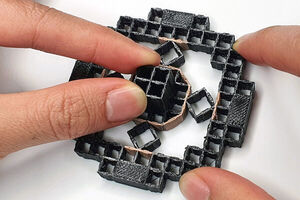
Engineers create 3D-printed objects that sense how a user is interacting with them
"Advance incorporates sensing directly into an object’s material, with applications for assistive technology and “intelligent” furniture. MIT researchers have developed a new method to 3D print mechanisms that detect how force is being applied to an object. The structures are made from a single piece of material, so they can be rapidly prototyped. A designer could use this method to 3D print “interactive input devices,” like a joystick, switch, or handheld controller, in one go. To accomplish this, the researchers integrated electrodes into structures made from metamaterials, which are materials divided into a grid of repeating cells. They also created editing software that helps users build these interactive devices." [...]

UNSW scientists solve decade-old graphene oxide puzzle
"A fundamental discovery in materials science has potential applications for water filtration and energy storage. Imagine scattering a big box of LEGO bricks on your living room floor. A few days later you come back, and they have magically formed nicely organised piles by themselves. A team of researchers at UNSW have observed something just like that, but under a very powerful microscope, not someone’s house, and looking at atoms, not toy bricks. They observed this phenomenon on what they call a ‘wonder material’, graphene oxide (GO). The chemical compound is made up of a single layer of carbon atoms (in the LEGO analogy, the floor) with oxygen atoms attached (the LEGO bricks)." [...]

Making self-driving cars safer through keener robot perception
"PhD student Heng Yang is developing algorithms to help driverless vehicles quickly and accurately assess their surroundings. Aviation became a reality in the early 20th century, but it took 20 years before the proper safety precautions enabled widespread adoption of air travel. Today, the future of fully autonomous vehicles is similarly cloudy, due in large part to safety concerns. To accelerate that timeline, graduate student Heng “Hank” Yang and his collaborators have developed the first set of “certifiable perception” algorithms, which could help protect the next generation of self-driving vehicles — and the vehicles they share the road with. Though Yang is now a rising star in his field, it took many years before he decided to research robotics and autonomous systems. Raised in China’s Jiangsu province, he completed his undergraduate degree with top honors from Tsinghua University." [...]
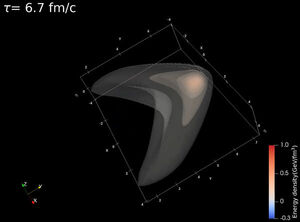
How to Catch a Perfect Wave: Scientists Take a Closer Look Inside the Perfect Fluid
"Berkeley Lab research brings us closer to understanding how our universe began Scientists have reported new clues to solving a cosmic conundrum: How the quark-gluon plasma – nature’s perfect fluid – evolved into matter. A few millionths of a second after the Big Bang, the early universe took on a strange new state: a subatomic soup called the quark-gluon plasma. And just 15 years ago, an international team including researchers from the Relativistic Nuclear Collisions (RNC) group at Lawrence Berkeley National Laboratory (Berkeley Lab) discovered that this quark-gluon plasma is a perfect fluid – in which quarks and gluons, the building blocks of protons and neutrons, are so strongly coupled that they flow almost friction-free. Scientists postulated that highly energetic jets of particles fly through the quark-gluon plasma – a droplet the size of an atom’s nucleus – at speeds faster than the velocity of sound, and that like a fast-flying jet, emit a supersonic boom called a Mach wave. To study the properties of these jet particles, in 2014 a team led by Berkeley Lab scientists pioneered an atomic X-ray imaging technique called jet tomography. Results from those seminal studies revealed that these jets scatter and lose energy as they propagate through the quark-gluon plasma." [...]

After 20 years of trying, scientists succeed in doping a 1D chain of cuprates
"The chemically controlled chains reveal an ultrastrong attraction between electrons that may help cuprate superconductors carry electrical current with no loss at relatively high temperatures. When scientists study unconventional superconductors – complex materials that conduct electricity with zero loss at relatively high temperatures – they often rely on simplified models to get an understanding of what’s going on. Researchers know these quantum materials get their abilities from electrons that join forces to form a sort of electron soup. But modeling this process in all its complexity would take far more time and computing power than anyone can imagine having today. So for understanding one key class of unconventional superconductors – copper oxides, or cuprates – researchers created, for simplicity, a theoretical model in which the material exists in just one dimension, as a string of atoms. They made these one-dimensional cuprates in the lab and found that their behavior agreed with the theory pretty well." [...]

New Research Examines 3D Coral Printing Possibilities
"As reefs face threats from climate change, Florida Tech is exploring 3D printing to potentially help sustain this critical but threatened ocean resource. Ocean engineering and marine sciences professor Stephen Wood and research students John Carroll, Sydney Goodman, Gabija Karosas, Alexa Langley, August Neier and Katherine Tyson are proposing to use a 3D printer to make coral structures that would then be placed upon large mounds of concrete in the ocean. The goal is to design a production method in which creating artificial coral reefs is accessible and affordable, and using 3D printing would decrease the time to produce artificial corals. The team is working to build a printer that is much larger than common printers on the market, which will allow them to print life-size corals. To reach their goals, the team assembled a smaller 3D printer to familiarize themselves with the mechanisms and construction of 3D printing. They then designed a full-scale 3D printer to print in ceramic, though there is a future option to print in concrete." [...]
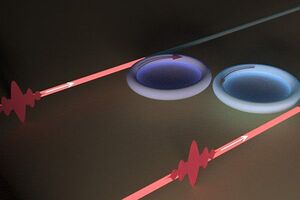
Engineering various sources of loss provides new features for perfect light absorption
"Natural and manmade physical structures all lose energy, and scientists work hard to eliminate that loss or compensate for it. Optical and photonic devices lose energy through light scattering, radiation or material absorption. In some situations, however, intentionally yet carefully designing loss in open optical devices and systems can lead to unconventional physical phenomena which inspires novel methods for optical control and engineering. Lan Yang, the Edwin H. & Florence G. Skinner Professor in Electrical & Systems Engineering in the McKelvey School of Engineering at Washington University in St. Louis, and a team that includes A. Douglas Stone, the Carl A. Morse Professor of Applied Physics and Physics at Yale University, and his lab uncovered new approaches to manipulating light absorption in optical resonators by different types of optical losses. They achieved a degeneracy of two coherent perfect absorbing modes, which leads to unconventionally broadened absorption spectrum and the capability to switch between weak and strong absorption over a broad frequency band. The work was published Sept. 9, 2021, in Science." [...]

Scientists create 3D-printed, microscopic gas sensors—painters’ pallets without even a hint of pigment
"Scientists from Trinity and AMBER, the SFI Research Centre for Advanced Materials and BioEngineering Research, have discovered a way to fabricate tiny colour-changing gas sensors using new materials and a high-resolution form of 3D printing. The sensors – responsive, printed, microscopic optical structures – can be monitored in real-time, and used for the detection of solvent vapours in air. There is great potential for these sensors to be used in connected, low-cost devices for homes, or integrated in wearable devices used to monitor human health. Most people spend much of their lives inside homes, cars, or work environments, so the ability to cheaply and accurately monitor levels of pollutants, for example, could be a game-changer within a health and wellbeing context. The work was led by Larisa Florea, Assistant Professor in Trinity’s School of Chemistry, and Principal Investigator at AMBER, in collaboration with Louise Bradley, Professor in Trinity’s School of Physics, and carried out in CRANN, the Trinity Centre for Research on Adaptive Nanostructures and Nanodevices. An industrial collaborator and leader in the field of gas sensing, Dr Radislav Potyrailo from GE Research, Niskayuna New York, has also been involved throughout." [...]

New physics research reveals fresh complexities about electron behavior in materials
"When electrons flow through a conductor — such as the copper wires in our phone chargers or the silicon chips in the circuit boards of our laptops — they collide with material impurities and with each other in a tiny atomic frenzy. Their interaction with impurities is well known. Yet, while understanding how electrons interact with each other is fundamental to understanding the physics, measuring the strength of these interactions has proven to be a tricky challenge for physicists. A team led by Virginia Tech researchers has discovered that by creating a specific set of conditions, they could quantify electron-electron interactions more precisely than ever. Their findings expand upon existing physics theories and can be applied to improving electronic devices and quantum computers. They recently published their findings in the journal Nature Communications." [...]
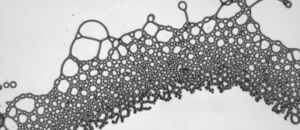
Physicists make square droplets and liquid lattices
"Driving systems out of equilibrium with electric fields proves useful for creating liquid shapes that are nearly impossible to find in nature When two substances are brought together, they will eventually settle into a steady state called the thermodynamic equilibrium; in everyday life, we see examples of this when oil floats on top of water and when milk mixes uniformly into coffee. Researchers at Aalto University in Finland wanted to disrupt this sort of state to see what happens — and whether they can control the outcome. ‘Things in equilibrium tend to be quite boring,’ says Professor Jaakko Timonen, whose research group carried out new work published in Science Advances on 15 September. ‘It’s fascinating to drive systems out of equilibrium and see if the non-equilibrium structures can be controlled or be useful. Biological life itself is a good example of truly complex behavior in a bunch of molecules that are out of thermodynamic equilibrium.’ In their work, the team used combinations of oils with different dielectric constants and conductivities. They then subjected the liquids to an electric field." [...]

New Technology Makes It Possible to See Clearly Through Murky Water
"Algorithm makes polarized imaging more practical for imaging through water, which could benefit rescues and other underwater applications Researchers have developed a new method that can automatically produce clear images through murky water. The new technology could be useful for searching for drowning victims, documenting submerged archaeological artifacts and monitoring underwater farms. Imaging clearly underwater is extremely challenging because the water and the particles in it tend to scatter light. But, because scattered light is partially polarized, imaging using a camera that is sensitive to polarization can be used to suppress scattered light in underwater images. “Our new method overcomes the limitations of traditional polarimetric underwater imaging, laying the groundwork for taking this method out of the lab and into the field,” said research team leader Haofeng Hu from Tianjin University in China. “Unlike previous methods, there’s no requirement for the image to include a background area to estimate the backscattered light.” In The Optical Society (OSA) journal Optics Express, the researchers demonstrate their method’s ability to enhance image contrast while preserving image details without introducing considerable noise." [...]
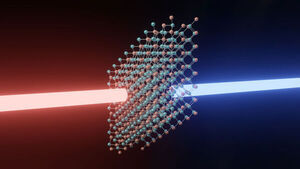
Ultrasound at the nanometre scale reveals the nature of force
"Researchers have developed a new method to measure force and atomic bonds at the nanoscale that reveals that the speed of sound depends on the structure it is travelling through. Scientists from the University of Nottingham and Loughborough University used a measurement method called picosecond ultrasonics, similar to medical ultrasound, to measure the strength of atom bonding within material. Their research has been published in Advanced Functional Materials. Force is fundamental to everything in daily life. From as large-scale as gravitational force that underlines the operation of the whole universe, to as small-scale as electron-electron interaction that can be hair raising. Force is very difficult to measure especially when the forces are too big or too small, this is especially the case when we enter the nanoworld, for example in the so-called two-dimensional van der Waals (2D-vdW) materials where objects have length scales in the range of 10-9 metres." [...]
Projetos Maker
Diversos Projetos interessantes.

360° Arduino Radar with 2xHC-SR04 Sensors
"In this case, it is interesting that are used two sensors to scan the entire 360-degree space. This time I will show you how to make Arduino-based ultrasonic radar. We could call it a Sonar because it is using sound, however, sonars are generally considered for use underwater. In this case, it is interesting that are used two sensors to scan the entire 360-degree space. Ultrasonic sensor modules are mounted on a servo motor that rotates between 0 and 180°. This method also simplifies the design because you don’t have the problem of cables getting tangled around the servo." [...]

Optical Keyboard
"This optical keyboard/keypad is a low-cost optical user input device capable of deployment underwater, explosive gas areas, or in other locations where hermetic sealing is desirable. It does not use capacitive, magnetic, mechanical, acoustic, or visible-light coupling. The reflection of an infrared beam is used at each keysite to determine finger presence. No part of this device need be in actual contact with the outside medium; a transparent window (possibly of variable thickness) may optionally be used. Emphasis is on ease of construction, low component count and cost, and low software processing cost. A current tradeoff is lack of operation capability in direct sunlight, which can be improved by inverting the present phototransitor biasing and additional software work." [...]
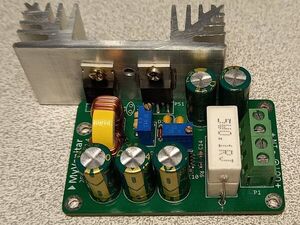
0-30V, 0-7A Adjustable Switching Power Supply
"0-30V, 0-7A Adjustable Switching Power Supply [CC-CV with LED] DC to DC buck converters is a famous topology in the electronic and a widely used circuit in electronic devices. A buck converter steps down the input voltage while it increases the output current. In this article/video, I have discussed a DC to DC buck converter that can be used effectively as a switching power supply. The output voltage and current are adjustable: 1.25V to 30V and 10mA to 6A (continuous). The power supply supports the constant voltage (CV) and constant current (CC) features. Two LEDs demonstrate the CV and CC status." [...]
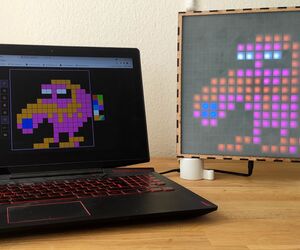
LED-Matrix With Web Server
"In my first Instructable we will build a 16x16 LED matrix. In the end you will have - obviously a LED matrix with 256 LEDs that are all individually controllable - a web page hosted on a microcontroller which allows you to - create pixel art live from the web page on the matrix - save creations - display all previous creations in a loop I started this project in October 2020, I bought all the parts and was looking forward to laser cutting the wood in my local FabLab. Unfortunately there were new lock downs due to the pandemic in my country and later I almost lost sight of the project. But this summer break I finally got started! For this project I decided to use a WS2815 LED-strip with 60 LEDs/m. - Each LED has a small IC, so we can control every LED's color and brightness individually using the data lines and an Arduino library like "FastLED" - With the LEDs being in a strip we basically don't have to solder - They are supplied with 12V DC." [...]

Creating a RISC-V system with an FPGA
"In this project you will learn how to implement a RISC-V processor in a SmartFusion2 SoC. Everybody knows that the processor of the moment is the RISC-V, even it is not a processor itself, the amount of the boards based on RISC-V is growing more and more. To understand the reason of that, we have to understand what is RISC-V, and what makes it different to Arm® or x86. First of all, we have to know that RISC-V is not a processor, like Arm or x86, they are an Instruction Set Architecture (ISA), In particular, it is an Open Instruction Set Architecture, and the open word makes the big difference between RISC-V and Arm or x86. I will explain it with an example, if I am an ASIC designer, and I want to integrate on my design a processor, I have two options, the first one and the most common until now was pay to Arm Limited, the owner of the Arm Architecture, to let me design a processor that uses their architecture, and be compliant with their instruction set. This will make my design arrive to a big number of developers that have their design compliant with the Arm architecture." [...]

Simple Raspberry Pi Weather Station
"This instructable teaches you how to make a simple weather station with your Raspberry Pi. As weather conditions become increasingly difficult across the world, it's a good idea to have a system for easily keeping tabs on the forecasts. This is also a great beginner's project and can be adapted to create a display for just about any type of information and with many different materials. Things you will do in this project: - Control LEDs with your Pi - Access weather data using Python - Solder fiddly bits of wire - Some (very) basic woodwork Supplies Materials - Some scrap wood - Raspberry Pi Zero W - LEDs (I used eight, but you may want more or less) - Adhesive labels (optional) - Wood adhesive - Hot glue (optional) - Wire and solder - 1K (or similar) ohm resistor - Screws to mount the Pi Tools - Soldering iron (and peripherals) - Dremel (or something else to cut and shape the display board with) - Drill" [...]
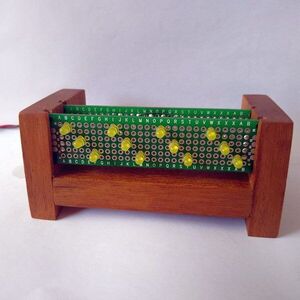
clOCkTAL
"Because binary coded decimal clocks are too easy to read. Binary Coded Octal clock with auto brightness control, based on a PIC16F688, developed with SDCC. Firmware The heart of this minimalist clock is the zero error Bresenham algorithm. It uses the Timer 0 to generate an interrupt at every 256 machine cycles. At every interrupt an accumulator is added by 256 up to the point where it overflows the amount of machine cycles in 1 second (Fclock/4 or 2000000). Every time the overflow occurs, the clock advances 1 second, and since such value is not divisible by 256, the difference is kept to be added to the next cycle." [...]

TinyML Made Easy: Gesture Recognition
"Seeed Wio Terminal programed using Codecraft/Edge Impulse is a fantastic tool for beginners to start on tinyML (Embedded Machine Learning). TinyML This project mixes Machine Learning (that is part of Artificial Intelligence) with a small device (Wio Terminal), which is nothing more than a microcontroller and sensors, whose main characteristics are ultra-low power consumption, 32-bit CPU, and a few kilobytes of memory. This new field of engineering is known as Embedded Machine Learning, or tinyML. As we know, Microcontrollers (or MCUs) are very cheap electronic components, usually with just a few kilobytes of RAM, designed to use tiny amounts of energy. Nowadays, MCUs can be found embedded in almost any consumer, medical, automotive, and industrial devices. It is estimated that over 40 billion microcontrollers are sold every year, and probably hundreds of billions of them are in service nowadays." [...]
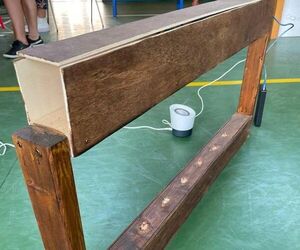
Laser Harp
"The laser harp was born as a remake of an old project. The basic idea is to create a variation of a classic instrument such as the harp using current electronic technologies, such as microcontrollers, sensors and speakers. The structure is made of wood. It has the shape of a rectangle of 96x47x6 cm. On the longer sides there are two separate circuits: on one there are six lasers in a row aligned with the six photoresistors placed on the opposite side. Lasers (in series) are powered by a 4.5 V battery." [...]
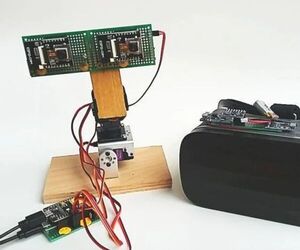
VR Distance Head With ESP32-cams
"Video conferencing can be boring, right? Better to see everything in 3D. Stereoscopic pictures are fascinating, so I decided to catch an image for each eye and send this to VR glasses. This tutorial shows how to build a moving VR camera with simple tools. It is for makers with experience in programming and uploading of Arduino and ESP32. Eyes: 2x ESP32-cam Head: - NodeMCU 8266 Amica - 3 Servos - pan & tilt kit - USB-Header VR display: - glasses (~20 €) - ESP8266-01 - MPU 6050 - LiPo battery Additional: - smartphone - soldering station + wire - pins, sockets - circuit boards - USB cables, power supplies/powerbanks Codes: - ESP32-cam1 - ESP32-cam2 - NodeMCU Amica - ESP8266-01" [...]

TinySewer - Low Power Sewer Faults Detection System
"A low power vision based sewer faults detection device using a tinyML to produce highly accurate sewer faults classification. In the U.S, there is around 2 million kilometer of sewer pipes around the country that supported 240 millions U.S citizen. Every year, at least 23 000–75 000 sewer pipe failures are reported in the United States, which releases up to 3–10 billion gallons of untreated sewage to the environment. This leads to a high economic loss, water pollution, and threatens communal health. These sewer pipes need yearly maintained to keep functioning properly and avoid sewer overflow. In most cases, sewer inspection is perform on site by an expert inspector, who usually use a remote control robot with camera to manually inspect the internal structure of the sewer." [...]
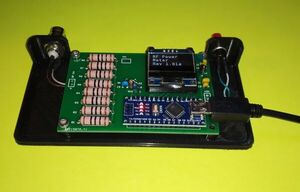
RF Load With Power Meter for HF Radios
"When building HF radio kits, one of the final steps before going on the air is to connect a 50-Ohm load and measure the RF power output. I used to do this by taking measurements with an oscilloscope and then calculating the power using formulas and a calculator. I built this project to automate this step by using an Arduino to measure the RF voltage, calculate the RF power and display the results. The circuit is relatively straightforward and it could be built using point-to-point wiring, but I decided to make the build easier by designing a circuit board. Referring to the schematic the circuit consists of a 50-Ohm load (made up of 8x 100-Ohm resistors) followed by a rectify/sample circuit which is then connected to an ADC (analog to digital) input pin of an Arduino Nano. The Nano is also connected via an I2C serial bus to an OLED display." [...]

ESP32 and Toit: Log sensor data to Google Sheet and emailing
"An ESP32 board will read pres and temp from BMP280 sensor and log the readings to Google Sheets. Furthermore, we'll also send email alerts. The majority of IoT applications revolve around the use of sensors to automate practically anything. Be it a home automation system, a weather monitoring station, or even a remotely controlled water pump for agriculture. In such applications, sometimes it is required to have the sensor data logged in a way that can, later on, be easily interpreted. No matter which platform or database you collect your data in, most people usually export the data to a spreadsheet for further analysis." [...]
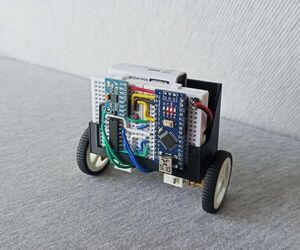
The Breadboarded Self Balancing Robot
"Being a Robotics enthusiast I always wanted to build a Self Balancing Robot but never build untill now. Self Balancing Robots are not a new thing to the world, what makes this build different from other Self Balancing Robots is the compact design and modularity of the build. The robot can be build by just plugging in various modules and can be assembled in a matter of minutes. So let's build one. The Breadboard A PCB is generally used to connect electronic components together but as we want our build to be modular and easy to assemble, the best way to do so is to use a breadboard. We will use 2 mini breadboards to connect everything electrically." [...]
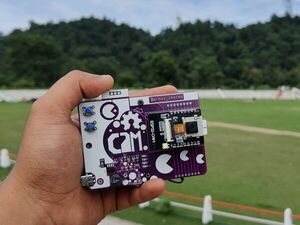
Dumb but Great Point and Shoot Camera with ESP32 CAM
"A completely portable ESP32 Based Point and Shoot Camera setup that works, kinda works. So the idea here was to take this very useful ESP32 CAM board and flash it with a sketch that lets us take an image and save it on the memory card. kinda like a proper point-and-shoot camera but this setup won't have any kind of display on it. which is a bummer but it works. these are the stuff that I used in this project: ESP32 cam Custom PCB (which were provided by PCBWAY) Lithium Cell 3.7V USB Micro Port IP5306 Power management IC 10uF 0805 Capacitor 2R 0603 Resistance (I didn't have the same package so I used 0805 Resistors) SMD LEDs 0603 1uH inductor Battery JST connectors Female Header pins Tick Tack switch 3D Printed body" [...]
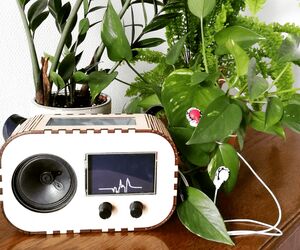
Plant-radio
"The plant-radio was build to enhance people's relation with their plants by being able to tap into the plant's electrophysiological signals and output the data as sound, pulsating lights and a graph. It was produced as part of a research project called Growing CoDesign, and we want it to live on here on instructables for other people to have the same experience of communicating with plants. In the video you can hear how the radio sounds. Casing: The main body of the radio is made in laser cut plywood. We've 3D printed the turnknobs and also a mount that is inside the radio holding the LED strip in place. In our version we've also attatched a leather strap onto the radio to make it portable, but this is optional for you to do." [...]

Smart Arduino Energy Monitor | ESP32 + Raspberry Pi + Home Assistant
"Hello to everyone, today I am going to show you a project that I've been working on for a while, it consist on an ESP32 based Smart Energy Monitor that takes current and voltage samples through sensors in our power grid and shares the data to a local server made with Home Assistant and Raspberry Pi. The electronics discrete components as resistors and transistors will be attached in a BOM file in the PCB Step. Materials: - Current sensor (CT) - Sensor de voltaje (PT) - OLED Display - Adafruit ESP32 Feather - Jack de audio hembra 3.5mm - Conectores hembra SIL - Varistor, 240v-200ma fuse,choke coil. " [...]
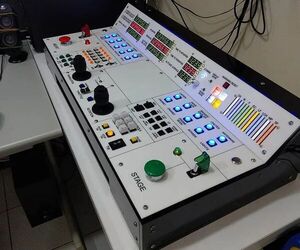
Kerbal Controller - the Basics
"The goal of this tutorial is not to show how to build a specific KSP controller, but to show many of the common design choices and their pros and cons. The idea is to guide you to make your own controller rather than showing you how to make one without explaining the 'why' behind it. For several subjects, this tutorial will only provide pointers to other resources dedicated to each topic (especially Sparkfun tutorials as I find them quite complete). What is KSP? Kerbal Space Program is a game where you build rockets and they fly them. If you don't know it, you may want to go look it up before continuing here." [...]

NRF Remote Control (NovaSM3 Project)
"Hello Lovely People, This remote control was designed and built by me for my NovaSM3 quadruped robot dog project. It could easily be used with any remote controlled device using a NRF module and some custom coding! ;) What you will need: - Arduino Mega 2560 Pro Embed - Lipo Battery - 2 OLED Displays - 2 Thumb Joystick Breakouts - Mini Momentary Push Buttons - NRF24101 Module - SPDT Rocker Switch - Sliding Potentiometers - Round Momentary Push Buttons - WS2812B 5050 Smart RGB LEDs - 5V Buck Converter - 3.3V Voltage Regulator - Solid Hook Up Wire - Resistors - 22uF apacitor - 3mm Hex Cap Screws - 3D printing filament of your choice" [...]

One MAN Clock
"We old timers know this as a MAN. Monsanto and Fairchild may have been first to use the acronym MAN for multi-segment alpha numeric led chip. The 7 segment display you often see. I see some interesting ways to produce the display with relays, flaps, and leds but they all have 4 numeric sections. This is as easy as it gets with only ONE MAN. To read the hours from the minutes the hours slightly blink while the minutes are steady." [...]
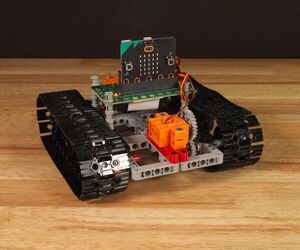
LEGO & Micro:bit RC Tank
"Here's a fun LEGO project that uses our Bit Board and micro:bit to power an RC tank, and another Bit Board and micro:bit to work as a remote control. We've listed all the LEGO parts we used, and also provided the needed code for the remote control transmitter and receiver. Electronics: 2 x Crazy Circuits Bit Board 2 x micro:bit 2 x LEGO Compatible 360 Degree Servo 2 x Thumbsticks 6 x Female to Female Ribbon Cables LEGO Parts: 6 x LEGO Beam Frame 5 x 7 (64179) 58 x LEGO Large Tread Link (57518 / 88323) 6 x LEGO Technic Sprocket Wheel 40.4 (57519) 4 x LEGO Beam 15 (32278 / 64871) 4 x LEGO Beam 7 (16615 / 32524) 20 x LEGO Technic Pin with Friction Ridges and Slots (2780 / 61332) 4 x LEGO Long Pin with Friction (6558 / 42924) 30 x LEGO Bushing (6590 / 42798) 4 x LEGO Half Bushing (32123 / 42136) 8 x LEGO Axle 8 (3707) 2 x LEGO Axle 5 (32073) 2 x LEGO Gear with 16 Teeth Unreinforced (4019) 2 x LEGO Gear with 24 Teeth (3648 / 24505) Misc LEGO Bricks, Baseplates, etc. " [...]
Secção Videos
Videos interessantes.
That's all Folks!



